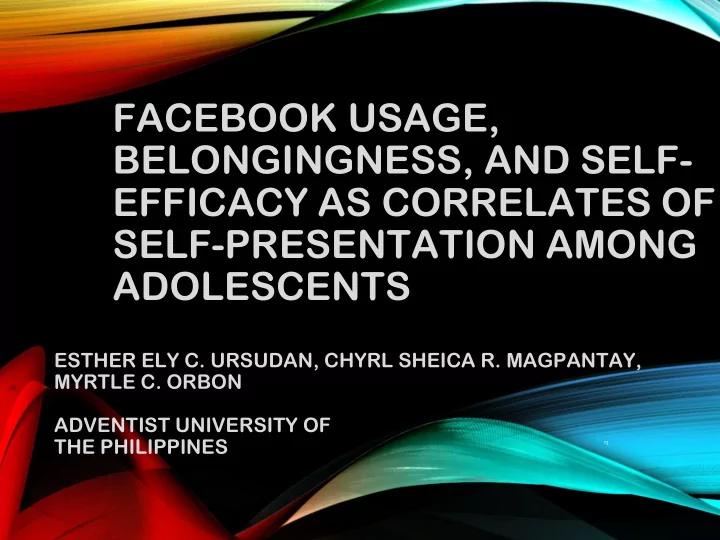

FACEBOOK USAGE, BELONGINGNESS, AND SELF- EFFICACY AS CORRELATES OF SELF-PRESENTATION AMONG ADOLESCENTS ESTHER ELY C. URSUDAN, CHYRL SHEICA R. MAGPANTAY, MYRTLE C. ORBON ADVENTIST UNIVERSITY OF THE PHILIPPINES Es
Adolescents are fond of using social media such as Facebook. There are studies conducted on determining Facebook usage and self-presentation of adolescents. Thus, the study is conducted to identify the respondents' Facebook usage, belongingness and self-efficacy and their relationship on self-presentation.
Questionnaires were administered to 182 selected respondents from different schools in National Capital Region (NCR) and CALABARZON to identify their Facebook usage, level of belongingness, self-efficacy and self-presntation.
Predictor VAriables Facebook Usage Criterion Variable Self- efficacy Self- presentation: Belonging ness
The findings show that respondents have high Facebook usage to check what is on the newsfeed ( M =3.32; SD =0.72) and to check the photos they were tagged ( M =3.29; SD =0.82). The respondents have high level of belongingness ( M =3.70; SD =0.46), high level of self-efficacy ( M =2.63; SD =0.44) and high level of self-presentation ( M =2.58; SD =0.39).
Grand Mean, Standard Deviation, Scale and Verbal Interpretation of Level of Variables Items Mean Scale Verbal (SD) Interpretation Facebook Usage 2.70 Somewhat Like High Facebook (0.44) Me Usage Belongingness 3.70 Often True High Sense of (0.46) Belonging Self-Efficacy 2.63 I Certainly Can High Self-Efficacy (0.44) Do Self-Presentation 2.58 Sometimes High Self- (0.39) Presentation
Correlation Analyses between the Respondents’ Belongingness and Self - Presentation Variable Self-Presentation r p Belongingness .10 .19 **. Correlation is significant at the 0.01 level (2-tailed). *. Correlation is significant at the 0.05 level (2-tailed).
The relationship between belongingness and self-presentation is ( r = .10, p < 0.05) not significant. This suggests that whether the respondent has low or high sense of belonging they perceive from their family and friends, it does not have any effect towards the respondent’s self-presentation.
Correlation Analyses between the Respondents’ Facebook Usage and Self - Presentation Variable Self-Presentation r p Facebook Usage .16* .03 **. Correlation is significant at the 0.01 level (2-tailed). *. Correlation is significant at the 0.05 level (2-tailed).
Table shows the correlation analysis of Facebook usage and self-presentation. The relationship between these two variables is ( r= . 16*, p<. 05). This indicates that there is positive significance correlation between Facebook usage and self-presentation. This may mean that when there is high Facebook usage, there is also high self-presentation. And when there is low Facebook usage, there is also low self-presentation.
Correlation Analyses between the Respondents’ Self -Efficacy and Self- Presentation Variable Self-Presentation r p Self-Efficacy .15* .04 **. Correlation is significant at the 0.01 level (2-tailed). *. Correlation is significant at the 0.05 level (2-tailed).
Table 14 shows the correlation analysis of self- efficacy and self-presentation. The relationship between these two variables is ( r= . 15*, p<. 05) significant. This indicates that there is positive significance correlation between self-efficacy and self-presentation. This may mean that when there is high self-efficacy, there is also high Facebook use. And when there is low self-efficacy, there is also low Facebook use. Having a self-efficacy may affect the respondent’s use of Facebook.
SUMMARY
Belongingness is not significantly correlated which indicates that feeling accepted is not related to presenting oneself desirably through Facebook. Moreover, Facebook usage and self-efficacy have significant positive correlation on self-presentation. The study implies that Facebook usage influences the respondents to present themselves in a desirable manner. Furthermore, the more they believe in their capacity to achieve goals, the more they present themselves favorably.
Recommend
More recommend